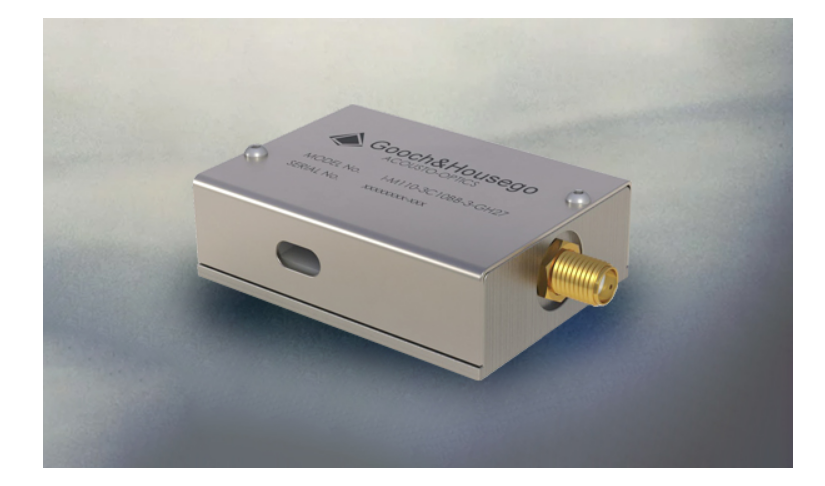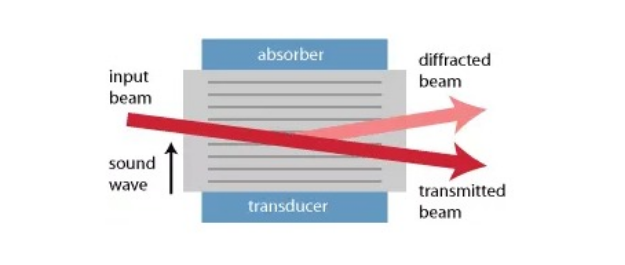

Light modulators are usually used to manipulate the properties of light beams, such as laser beams. Modulators are called intensity modulators, phase modulators, polarization modulators, spatial light modulators, etc., according to the modulated light beam's properties. Different modulators can be applied to various application fields, such as optical fiber communications, display devices, Q-switched or mode-locked lasers, and optical measurement.
Acousto-optic modulator abbreviation: AOM is a device that uses an electronic drive signal to control the power, frequency, or spatial direction of a laser beam. It utilizes the acousto-optic effect. That is, the refractive index is changed by the mechanical oscillation pressure of sound waves.
The critical element of AOM is a transparent crystal (or a piece of glass) in which light travels. The piezoelectric transducer in contact with the crystal is used to excite sound waves, the frequency of which is on the order of 100 MHz. The light propagates in the periodic refractive index grating and is subjected to Bragg diffraction to produce acoustic waves, so AOM is sometimes called Bragg cell.

The frequency of scattered light increases or decreases. The value of the increase or decrease is equal to the frequency of the sound wave (related to the propagation direction of the sound wave relative to the beam), and the movement of the scattered light changes slightly. (The difference in order is slight, as shown in the figure, because the wavenumber of sound waves is very small compared to light waves.) The frequency and direction of scattered light can be controlled by controlling the frequency of sound waves, but the power of sound waves is limited by sunlight. When the sound wave power is high enough, more than 50% of the light intensity is diffracted, and in the limit, more than 95% of the light energy is diffracted.

Sound waves may be absorbed in the other end of the crystal. This traveling wave structure makes it possible to achieve a wide modulation bandwidth. Other devices resonate with sound waves, using the strong reflection of sound waves from the other end of the crystal. The resonance effect can significantly increase the modulation depth (or reduce the required acoustic power), reducing the modulation bandwidth.
Common materials for acousto-optic modulators are tellurium dioxide (TeO2), quartz crystal, and fused silica. There are many criteria for material selection, including electro-optical coefficient, transparency range, light damage threshold, and required size. Different sound waves can also be used, and the most commonly used is longitudinal wave (compression). In this way, the highest diffraction efficiency can be obtained, and the diffraction efficiency is also related to the beam's polarization. When using acoustic shear waves (acoustic vibration direction is the same as the laser beam), it has nothing to do with the polarization direction, reducing the diffraction efficiency.
There are also integrated optical devices that contain multiple acousto-optic modulators on a chip. Optical devices can be integrated on lithium niobate. Because it is piezoelectric, the metal electrodes on the chip's surface can generate surface acoustic waves. This device has many uses, for example, as a tunable optical filter or optical switch.
Acousto-optic modulators have many applications:
It can be used as a Q switch in solid-state lasers. AOM is also called Q-switch, which is used to close the laser cavity before the pulse is generated. In most cases, only the zero-order beam meets the laser conditions, and the AOM can be turned on when the laser is not needed. At this time, the diffraction loss (loss caused by each round trip to the resonator) is required to be greater than the laser gain. For high-gain lasers (for example, fiber lasers), the first-order diffracted beam meets the laser conditions, so when the AOM is turned off, tremendous cavity loss will occur. However, the loss of the laser state is also relatively high.
AOM can also be used as a tilted cavity for solid-state lasers to generate nanosecond or ultrashort pulses. In the latter case, the speed of the AOM only meets the requirements when the resonant cavity is relatively long or an electro-optic modulator is required.
Using AOM to adjust the resonant wave loss of the round-trip flight in the deep cavity can realize active mode-locking.
AOM can be used as a pulse picker to reduce the pulse repetition rate of the pulse train to perform the subsequent amplification process of the pulse to obtain high pulse energy.
In laser printers and other devices, AOM can modulate the power of the laser beam. Modulation can be continuous or digital (on/off).
AOM will shift the laser beam's frequency, for example, used in various measuring devices or used in lasers that use frequency-shifted optical feedback to achieve mode-locking.
In some cases, it is necessary to use the effect of diffraction angle and acoustic frequency. In particular, what can scan the outgoing beam's direction (at least a small range) to change the modulation frequency.